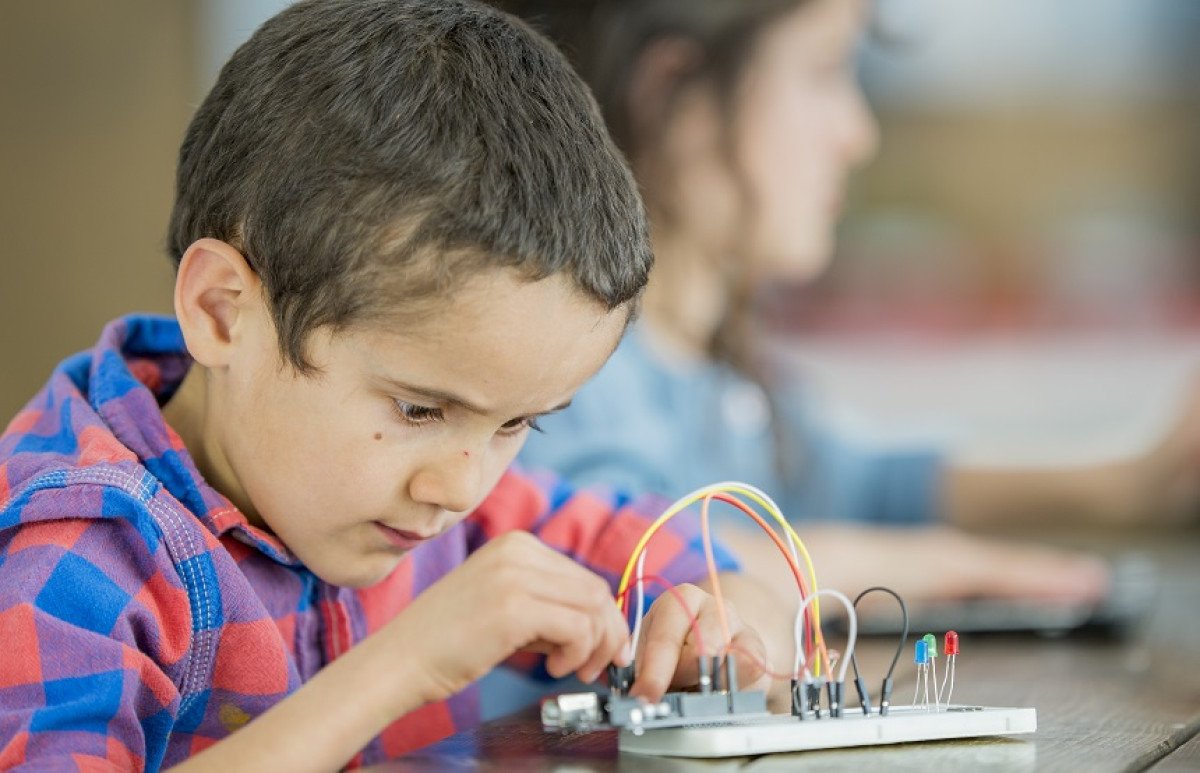Tips for teaching electromagnetism, from a Science World expert
Errors in electromagnetism would not be a good thing for BC Hydro's hydroelectric generation, which powers the province through falling water by leaning on electromagnetism to transform mechanical electricity into power.
But when teaching electromagnetism in the classroom by building a motor, errors and tweaks are just part of the adventure.
"I think it's a really great opportunity for learning because, the real world is a little bit fancier, a little bit trickier, than the picture in the book," - Sandy Eix, physicist and director of STEM learning at Science World.
"You try to make the motor spin, and it doesn't always happen. It takes a bit of persistence to do it, and figuring out what you need to change in order to make it work, well, that's part of the learning, and there's a real sense of accomplishment when you get it right." Eix believes in letting students know in advance that errors are okay. She also says that working in small groups – one set between two students when building a motor, for example – is a great approach. "This way, kids are allowed to bounce their ideas off each other, try things, and talk about them," she says. "That's the way science works – scientists don't work alone in dark boxes."
Power Smart For Schools offers a 4-pack of activities around electromagnetism for Grade 7 students, including – you guessed it – building an electric motor. It all makes sense for an electrical utility that leans so heavily on electromagnetism to power the province.
How electromagnetism works, and why it matters
Electromagnetism is literally the science of charge, and of the forces and fields associated with charge. The concept can be tough for kids – and just about everyone – to get their heads around.
It wasn't until 1821 that English physicist Michael Faraday, whose work forms the basis of electric power generation, discovered that a changing magnetic field produces an electric field. His work produced mechanical motion by means of a permanent magnet and an electric current, an ancestor of the electric motor.
And it wasn't until the 19th century – specifically with Albert Einstein's 1905 special theory of relativity – that electricity and magnetism were widely accepted as separate forces.
"I think of both electricity and magnetism as very puzzling and mysterious to people because it's hard to see the effects of these things," says Eix
"You can't see them, and they're not something you can touch. But they're super important, because so many things in our life run on electric power. But once we understand how that works, we can make great choices about the electric things we use, and how we use them."
Eix says most people are unaware that electromagnetism is key to most power generation options, from renewables such as hydroelectricity, geothermal and wind, to fossil fuel options such as coal, oil, and natural gas. In hydroelectricity, for example, the power of falling water is converted to mechanical energy via electromagnetism, which is created when a magnet moves past a conductor.
While it may be a tough concept to explain, it's something we can demonstrate in a fun way in the classroom.
The basics of hydroelectricity and electromagnetism
The Power Smart for Schools' Grade 4 activity on Energy Transformations and Hydroelectricity is a great place to start with younger students. It describes hydroelectric power generation as follows:
- Water in the reservoir has potential energy
- Water at the top of the penstock (the 'tunnel' that brings the water to the turbine) has gravitational energy.
- Water moving down the penstock has kinetic energy.
- Turbines have mechanical energy as they're turned by the moving water.
- Generators have mechanical energy as they’re turned by the turbines.
- Generators create electrical energy as magnets spin past coils of copper wire (electromagnetism).
The Grade 4 activity includes a slideshow and video, and encourages you to share with your students the fact that over 95% of electricity in B.C. is created by transforming the energy from falling water. Ask them to share what they already know about hydroelectricity, and have them think about the energy transformations that happen in hydroelectric systems.
For an overview of electromagnetism, you may want to show students the three-minute National Geographic video Electromagnetism 101.
Tips for teaching and playing with electromagnetism
The magic of magnets is another great way to get students' engaged, says Eix.
"Magnets are fascinating and a great thing to play with and explore," she says. "You can do basic cause and effect stuff and really play around as you experiment with what sticks, and what doesn't stick, to a magnet. What happens when you bring two magnets together? The next step, mixing that with electric current, is a bit fancier, and works best with kids of 10 and older."
The majority of Power Smart For Schools' electromagnetism activities are targeted for Grade 7 students, as that maps to the B.C. curriculum. They're nicely bundled under the umbrella of Electromagnetism, but include a basic investigation; find the magnetic field, to linking magnetism and electricity, to building an electric motor, and building an electromagnet.
Science World also offers related activities, including Electrifying Electromagnets and Oersted's Experiment in the Electrical Energy activities section of science worlds website.
It's the hands-on activities that really resonates with students. Eix says that in her years working at Science World, watching kids sort things out brings the greatest joy. She's a physicist who feels that while she has a responsibility to explain the science, there's nothing quite like making it happen.
"It really helps to have a visceral understanding of how a phenomenon works," she says. "Even if you can't explain it in words. People love it when they make a thing and it moves, right? It's like, yep, that's pretty cool. And there's not a lot of things like magnets that can affect other things at a distance. That magic is universally appealing."
Teaching electromagnetism, like teaching any type of science, is about creating and maintaining engagement. Here are five ways to help ensure you have a captive, interested audience in the classroom:
- Ask questions as you go along
Encourage curiosity and conversation. Instead of just telling students about the science, encourage them to work things out for themselves, as a group. - Don't oversimplify the science
It's a fine balance between getting too much into the underlying theory of a project or experiment, but as you read a class's progress in understanding, don't be afraid to challenge them. - Choose words wisely and avoid jargon
You don't have to dumb things down, but jargon and vocabulary can trip students up. Take the time to explain new terms so that they're understood. - Make concepts relatable
Everyday examples and/or myth busting is a fun way to keep students engaged. - Get ready for the difficult questions
Curiosity often produces tough questions that can sometimes challenge what you're saying. Be ready to address questions by budding critics.
Educational resources for exploring electromagnetism
Because they can be so enlightening, and so much fun, we offer a wide variety of Power Smart for Schools activities to help students understand not just the science of electromagnetism, but also how important it is to the generation of power in B.C.
Energy transitions and hydroelectricity (Grade 4)
While not specifically getting into the details of electromagnetism, this activity is a great primer on types of energy and how they apply to hydroelectric power generation. The activity includes a popular "How a dam works" video.
Electromagnetism (Grade 9)
A set of activities uses a variety of everyday items (batteries, magnets, compasses, iron and paper clips) to reveal the connection between electricity and magnetism.
Find the magnetic field (Grade 9)
Using bar magnets and iron filings, you and your students can explore the properties of magnetic fields, just like the one that surrounds the Earth.
Linking magnetism and electricity (Grade 7)
Students create a simple circuit so that they can explore the connection between electricity and magnetism.
Build an electric motor (Grade 7)
Students build electric motors that are enabled by magnets.
Build an electromagnet (Grade 7)
It's an exploration, and a competition. After challenging themselves to create a simple electromagnet, students can then challenge each other to see which prototype is the strongest. The students who pick up the most paper clips with their electromagnet win.
Atomic models and electricity (Grade 8)
Four activities – exploring charges, batteries, positive and negative electrons, and the atomic model itself – that help students think critically about the relationships between atomic models and electricity.
Safety around power lines (Grades 4-7)
The electromagnetic forces that produce both electricity and magnetism can also create danger when electricity travels, including when power lines are down. Students learn about the ways electricity can travel, code an electrical safety message, and play a game testing their electrical safety knowledge.






